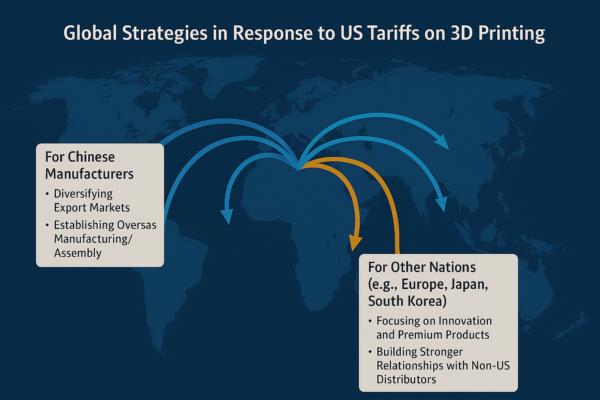The recent surge in tariffs, particularly in the US, is undeniably shaking the global 3D printing landscape. While the immediate impact is felt by US consumers facing higher prices for imported 3D printers, the long-term implications demand a more nuanced, global perspective. What happens when reliance on certain international suppliers, like those in China, remains a necessity due to compelling quality and price, even with hefty tariffs? And how should companies and nations beyond the US respond to this evolving trade environment?

Acknowledging the Inevitable Interdependence: A Short-Term Reality
As you rightly point out, the allure of Chinese 3D printers and resins often lies in their impressive quality-to-price ratio. Even with substantial tariffs, the final cost in the US might still undercut the current production capabilities and cost structures of domestic alternatives. This creates a challenging reality where short-term reliance on established suppliers remains likely.
Consider companies like IFUN, for example. While the broader market grapples with tariff-induced price hikes on standard 3D printers and materials, IFUN has carved a niche by specializing in industry-specific applications, particularly jewelry 3D printers and dental 3D printers, along with their corresponding jewelry casting resins and dental resins. Their value proposition extends far beyond simply selling hardware and materials. IFUN focuses on providing a comprehensive industry application solution, actively working with clients to fine-tune machine parameters and resin formulations to meet the precise standards required for their specific use cases. This deep level of technical service and application expertise creates a significant barrier to entry for competitors looking for a quick replacement.

Strategies for Navigating Short-Term Dependence
Given this reality, US-based businesses and consumers need strategies to mitigate the pain of high tariffs while longer-term solutions take shape:
- Absorption of Costs (Where Possible): Distributors and retailers might need to absorb a portion of the tariff costs to remain competitive, even if it impacts profit margins.
- Optimized Inventory Management: Strategic stockpiling (if feasible and before further tariff hikes) and efficient inventory management can help buffer against immediate price fluctuations and supply disruptions.
- Focus on Value Beyond Price: Emphasizing factors like local support, faster shipping (for domestically stocked items), and warranties can help justify potentially higher prices for non-imported options. For specialized providers like IFUN, their inherent application-specific expertise and support already constitute significant added value.
A Global Perspective: Responses Beyond US Borders
The US tariff policies also necessitate strategic responses from companies and nations outside the US:
For Chinese Manufacturers:
- Diversifying Export Markets: Reducing reliance on the US market by actively exploring and expanding into other regions with less restrictive trade policies.
- Establishing Overseas Manufacturing/Assembly: Setting up production or assembly facilities in countries with favorable trade agreements with the US (as mentioned before) to circumvent tariffs.
- Focusing on Innovation and Premium Products: Shifting towards higher-margin, technologically advanced 3D printers and materials where price sensitivity might be lower. Companies like IFUN, with their specialized jewelry 3D printer and dental 3D printer offerings, are already operating in this higher-value space.
- Building Stronger Relationships with Non-US Distributors: Partnering with distributors in Europe, Asia, and South America to maintain global sales volume. For companies like IFUN, their established technical service model can be a key differentiator in these new markets.
For Other Nations (e.g., Europe, Japan, South Korea):
- Capitalizing on the Shift in Competitive Landscape: Their 3D printing manufacturers might find new opportunities to gain market share in the US as Chinese products become more expensive. However, even they will need to contend with established players like IFUN in specialized sectors where application-specific knowledge is paramount.
- Strengthening Domestic Industries: Investing in their own 3D printing research, development, and manufacturing to become more competitive globally.
- Maintaining Open Trade Policies: Advocating for and maintaining open trade relationships to ensure access to a diverse range of 3D printing technologies and materials.

The Long Game: Fostering a Resilient Global Ecosystem
Ultimately, the goal should be a resilient global 3D printing ecosystem. This involves:
- Encouraging Fair Trade Practices: Promoting international dialogue and agreements that reduce trade barriers and foster fair competition.
- Supporting Innovation Globally: Encouraging and funding research and development in 3D printing across nations to drive technological advancements.
- Building Diverse and Robust Supply Chains: Reducing over-reliance on any single country or region for critical components and materials. For companies like IFUN, maintaining strong relationships with their specialized resin suppliers and continuously innovating their application solutions will be key to their long-term success, regardless of tariff fluctuations. Their service-oriented model, focused on helping customers achieve specific application standards with their jewelry casting resins and dental resins, creates a level of integration that simple product replacements cannot easily replicate.
A World of Interconnected Threads and Specialized Expertise
The impact of tariffs on the 3D printing industry is a complex web of interconnected threads. While the US market faces immediate price pressures, the long-term solutions require a global perspective that acknowledges existing strengths and dependencies. Recognizing the current realities of quality, price competitiveness, and the value of application-specific expertise necessitates both short-term coping mechanisms and long-term strategic adjustments. Fostering domestic innovation in the US, encouraging diversification globally, and recognizing the unique value proposition of companies that offer integrated solutions and technical services will be crucial in shaping a more resilient and dynamic future for the 3D printing ecosystem. The path forward requires not just national strategies, but a collaborative global approach that appreciates the nuances of specialized expertise and application-driven value.